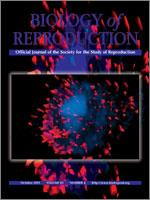Estradiol-17beta (E2) is the major regulator of GnRH receptor (GnRHR) gene expression and number during the periovulatory period; however, the mechanisms underlying E2 regulation of the GNRHR gene remain undefined. Herein, we find that E2 conjugated to BSA (E2-BSA) mimics the stimulatory effect of E2 on GnRH binding in primary cultures of ovine pituitary cells. The time course for maximal GnRH analog binding was similar for both E2 and E2-BSA. The ability of E2 and E2-BSA to increase GnRH analog binding was blocked by the estrogen receptor (ER) antagonist ICI 182,780. Also, increased GnRH analog binding in response to E2 and the selective ESR1 agonist propylpyrazole triol was blocked by expression of a dominant-negative form of ESR1 (L540Q). Thus, membrane-associated ESR1 is the likely candidate for mediating E2 activation of the GNRHR gene. As cAMP response element binding protein (CREB) is an established target for E2 activation in gonadotrophs, we next explored a potential role for this protein as an intracellular mediator of the E2 signal. Consistent with this possibility, adenoviral-mediated expression of a dominant-negative form of CREB (A-CREB) completely abolished the ability of E2 to increase GnRH analog binding in primary cultures of ovine pituitary cells. Finally, the presence of membrane-associated E2 binding sites on ovine pituitary cells was demonstrated using a fluorescein isothiocyanate conjugate of E2-BSA. We suggest that E2 regulation of GnRHR number during the preovulatory period reflects a membrane site of action and may proceed through a nonclassical signaling mechanism, specifically a CREB-dependent pathway.
How to translate text using browser tools
6 July 2011
Does a Nonclassical Signaling Mechanism Underlie an Increase of Estradiol-Mediated Gonadotropin-Releasing Hormone Receptor Binding in Ovine Pituitary Cells?
Tracy L. Davis,
Jennifer D. Whitesell,
Jeremy D. Cantlon,
Colin M. Clay,
Terry M. Nett
ACCESS THE FULL ARTICLE

Biology of Reproduction
Vol. 85 • No. 4
October 2011
Vol. 85 • No. 4
October 2011
GnRH receptors
membrane estrogen receptors
ovine
pituitary




